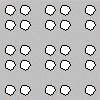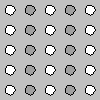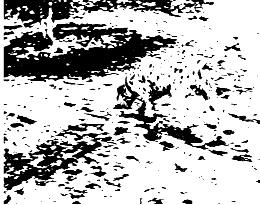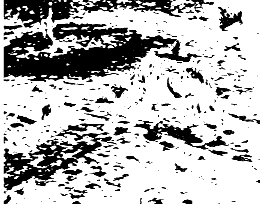Gestalt theory: Visual and Sonic Gestalt
Alex McLean, MSc Arts Computing
1st November 2005
Introduction
Gestalt theory puts forward the primacy of the whole in
perception, not as an accumulation of perceptions of its parts
but in something more. Our perceptions are subconsciously
constructed towards the end of creating a perception as stable,
or as "good" as possible. Our conscious mind is then presented
with this organised percept of the whole.
Gestalt theory is weak when it attempts to justify itself
through physiological explanation. We simply do not yet know
enough about the brain to explain perception in this way, and so
to get at the truth we isolate figures which evoke Gestalt
percepts, that is percepts showing features not in the parts but
in our perceptual construction of the whole.
The focus of Gestalt theory has largely been upon visual
phenomena, but good research is being done on sonic and musical
Gestalt theory too. The essay will explore the principles of
Gestalt theory using both visual and aural examples. It will
then look at some of the applications of Gestalt theory within
the study of music, and conclude with an analysis of some of the
criticisms of the theory.
Commonalities between Visual and Sonic Gestalt
From one perspective, visual and sonic perception could not
be more different, one is spatial perception, the other
temporal. However it is easy to see how each contains elements
of the other - visual perception also changes over time, when we
look at moving or changing forms, even when we see a static
image our eyes move across it in meaningful patterns. Further,
our two ears allow us to detect distance and direction, and our
musical sensibilities perceive movement in a space defined by
such dimensions as timbre, pitch, duration, distortion,
resonance and so on.
Gjerdingen applies the Grossberg-Rudd neural model of
apparent movement in vision to music with favourable results.
He goes on to highlight striking analogs between visual and
aural perception such as luminance/amplitude and colour/timbre.
But yet the overall experience of seeing and hearing seem to be
such different experiences. Gjerdingen offers a compelling
explanation for this, that while high-level cognition of vision
and sound may be analogously weak, their low-level neural
processes show striking similarities. That is, even though
sound and light are very different mediums, the brain may
process them in very similar ways.
With this low-level commonality in mind, I have explored
Gestalt principles by constructing both visual and audio
examples in the following section.
Sonic vs Visual Gestalt - examples
The following examples aim to illustrate, in a
straightforward manner, presence of gestalt principles across
visual and aural perception. Note that the audio examples are
of my own devising, and have not met with rigorous scientific
testing. The principles exemplified are based on those seen in
lectures by Professor Leymarie, Goldsmiths College, 2005.
When viewed with a java-enabled browser, the visual examples
will be clickable to reveal or highlight a gestalt effect. They
were made using the processing java
environment. The audio examples were rendered using Perl, in
some cases using my feedback.pl
environment triggering synthesis by my datadirt software.
Sourcecode for all examples is linked.
Proximity / Contiguity
In the audio example we hear identical sounds played, but
group them into sets of four and three sounds because of their
proximity on the musical surface of the time line. This is
analogous to the grouping of visual properties by proximity,
for example in the two dimensional space of figure 1.
audio: (
ogg |
mp3 |
sourcecode )
Similarity
This audio sample demonstrates how we group sounds by
similarity. The sounds are the same distance apart
temporally, but are pitched differently. We see an analogous
effect using shading in figure 2.
audio: (
ogg |
mp3 |
sourcecode )
Proximity and similarity in conflict
In the following audio sample you can hear differences in
pitch suggesting groupings in conflict with those suggested by
difference in temporal distance. You can see the visual
equivalent effect by clicking upon figure 2.
audio: (
ogg |
mp3 |
sourcecode)
Gestalt principles lead us towards certain grouping
judgements, but as we have just seen and heard, they often
conflict. This leads to an uncertain judgement, or in some
extreme cases an unstable one, where we flip between two
judgements (as in figure 6). However, usually one principle
overrules the other, and these relative strengths may be
measured through controlled testing. Some of the tests
performed in the study of Lerdahl & Jackendoff's Grouping
Preference Rules (GPR) are explored later in this essay.
Closure / Good continuation
This audio example contains a number of evenly spaced
sounds of fixed duration, with silence in between. However,
together the sounds are likely to be perceived as a continuous
movement. The effect is still present when listening on
closed-backed headphones, which rules out environmental reverb
as a factor in joining the sounds.
audio: (
ogg |
mp3 |
sourcecode )
Figures 3 and 4 show equivalent visual effects, showing a
distinction between closure where lines are joined together to
find the simplest form, and continuation where we prefer the
simplest path when perceiving lines. After clicking on figure 3
we realise that the perceived white triangle is invisible, and
clicking on figure 4 reveals an alternate, less preferable
grouping of the lines than we would normally see.
Figure 3 is a visual illusion that fools us into perceiving
what is not there. So strong are the clues to a super-imposed
white triangle that we are likely to see a phantom,
illusionary shading around it. Equivalent sonic illusions
exist too; Diana Deutsch researches in the area of sonic and
musical illusion, finding arrangements that listeners tend to
perceive as different from their reality. For example, her
"octave illusion" causes people to hear different tones in
different ears. What is heard differs from person to person
but rarely reflects the actual pitch and panning of the
sounds.
Area / smallness
Figure 5 show that area has a role to play in perception,
we tend to perceive the smaller area as figure and
the bigger one as ground. Figure being an object,
ground being the background on which it is placed.
I attempt to reproduce the visual effect of figure 5 in
audio by contrasting bursts of white noise with bursts of
silence (if you can have a burst of silence). I chose this
contrast because being devoid of any features, white noise is
structurally similar to silence. Indeed in many situations
the brain interprets noise as silence, for example the
background hiss of a radio or tape recording. [1]
The duration of the noise and silence is varied as an analog
to varying area in figure 5. I suggest it is easier to
interpret the shorter silence as the figure against the
ground of the noise in audio example one, and the shorter
noise as figure against the ground of silence in example
two.
Example 1:
audio: (
ogg |
mp3 |
sourcecode )
Example 2:
audio: (
ogg |
mp3 |
sourcecode )
Figure and ground
We have already encountered figure and ground in the
previous example. Such interrelationships and overlaps are
found between many of the Gestalt principles. Indeed, area
could also have been used to illustrate the similarity rule,
commonly sized shapes being more likely to be perceived as a
group.
Figure 6 shows an unstable figure-ground relationship. We
can either see two symmetrical faces or a vase, but probably
not both at the same time. For the audio example, I chose a
different technique to explore figure and ground
relationships; polyrhythm.
audio: (
ogg |
mp3 |
sourcecode )
This polyrhythm has four repeating sounds, each spaced
differently. One sound plays every third time unit, one every
fourth, one every tenth and one every fourteenth. This
creates a pattern that repeats every 840th time unit, but it
would seem likely that we would perceive a looping sooner than
that. I perceive it repeating every twelfth unit. This
perceived loop point could be considered the ground over which
the other features create combinations as varying figures.
Our choice of ground and figure could be a product of features
of the sounds themselves such as volume and attack time, as
well as the mathematical interactions between the different
spacings.
Musical Gestalt
Western musical theory considers Gestalt Theory in two main
areas; grouping/segmentation and expectation, which I shall
explore separately.
Grouping and Segmentation
In "A Generative Theory of Tonal Music", Fred Lerdahl and Ray
Jackendoff define sets of rules for analysing music. For the purposes
of this essay, we focus on the grouping rules, which are separated
into two sets, first the five Grouping Well-Formedness Rules (GWFR)
and second, the seven Grouping Preference Rules (GPR). The GWFR
simply define some structural constraints, simply put:
- GWFR 1: A group is a contiguous sequence of sound events.
- GWFR 2: A musical piece is a group.
- GWFR 3: A group may contain smaller groups.
- GWFR 4: A group may not belong to more than one group.
- GWFR 5: A group must be exhaustively partitioned into groups if it is
partitioned at all.
So what we are left with is a simple tree structure, where groups
contain groups, the biggest group being a whole musical piece, and the
smallest group being a note or drum beat that cannot be partitioned
further without going beyond the limits of classical musical notation.
Between those lie groupings such as motives, themes, phrases, periods,
theme-groups and sections.
Their GPR are the rules for how these
groups might be chosen. They name seven, which I summarise;
- GPR 1: Strongly avoid groups containing a single event. Avoid
analyses with very small groups - the smaller, the less preferable.
- GPR 2: Proximity - tend towards marking boundaries where a gap is
heard, measured either as time between the end of one note and the
beginning of the next (the rest) or as the time between their attack
points (the inter-onset interval or IOI).
- GPR 3: Change - in register, dynamics, articulation, length, timbre or
instrumentation.
- GPR 4: Intensification - where effects of groupings formed by GPR 2
and 3 become more pronounced, the groups may be split into two higher
level groups.
- GPR 5: Symmetry - tend towards grouping two parts of equal length.
- GPR 6: Parallelism - where segments of music are similar, tend towards
grouping them in the same way.
- GPR 7: Time-Span and Prolongational Stability - tend towards
large-scale groupings that allow the greatest stability of the
groupings within it.
The relative strengths of their rules are largely unspecified
and untested by Lerdahl & Jackendoff, but they explicitly
invite others to research further. Here follows an exploration
of some of those who accepted this invitation.
Frankland & Cohen identified the GPR 2 proximity rule and
the GPR 3 change rule as being "local grouping rules" most
fundamental to low level grouping structure within the
Generative Theory of Tonal Music. They tested and quantified
the Rest and Attack Point aspects of GPR 2 and the Register and
Length aspects of GPR 3. The results broadly supported the
overall theory, but found the Attack Point rule to be by far the
strongest of those they measured, and suggested use of the other
rules to be tempered in light of this.
Though his study of the Local Boundary Detection Model
(LBDM), Emilios Cambouropoulos extends GPR 3 to suggest that
change is not always on grouping boundaries, but between the two
events that proceed a boundary. In experiments with expert
performances of the work of Chopin, he found that while less
than 50% of notes on boundaries were lengthened, 92% of notes
proceeding them were lengthened. These figures could be arrived
at because Cambouropoulos chose a 20 bar section of a piece
where boundaries were unambiguous and uncontentious.
Cambouropoulos proposes one hypothesis that might explain this
tendency for the penultimate note in a group to be emphasised -
"When a note IOI is long in relation to its surrounding notes,
further lengthening should be quite significant in absolute
terms for it to be perceptible whereas a much smaller
lengthening of a preceding short note)delay of long note) is
more effective." An interesting idea that requires further
research and testing.
The tests of Deliège [1987] backed up an interesting
assertion by Lerdahl & Jackendoff that groupings are more
easily identified by more experienced listeners, which Deliège
clarified as trained musicians. However she found non-musicians
also mostly made segmentations in line with the rules, and so
concludes that these grouping preference rules may be applied
broadly.
Deliège and Frankland & Cohen were in agreement in
suggesting that the GPR are incomplete. The results of
Deliège's tests suggest a need for a rules based on changes in
harmony, and she goes on to suggest additional rules might be
based on sound density.
Expectancy
The other major area of influence of Gestalt over music
theory is on expectation.
Wertheimer and Koffka pointed out that perception is not
merely a product of the environment. Although our influence
over what we perceive is largely unconscious, it is nonetheless
active. What we have perceived before has influence over what
we will see again. Supporting evidence is popularly found with
Dalmatian as photographed by R. C. James (figure 7).
This helps explain expectation as a cultural phenomenon. We
learn to expect things based on what we have experienced before.
It is much easier to parse the dalmatian image having already
seen it, even when many years have passed in the meantime - our
memory in some way tells us what to expect. But what happens
when that expectation is unfulfilled?
Figure 8 shows an attempt to scramble many of the identifying
elements that form the percept of the dalmatian. Having seen
her so many times, we expect to do so again in this
altered image. We quickly realise that she has gone, but
nonetheless the expectation of her presence remains in her
place. [2].
This phenomenon is observable in the world of music too.
Even in a well-known and loved piece, unfulfilled expectation
remains an important feature of the music. How can we continue
to expect something that we know is simply not there?
The answer may be found by dividing expectation into two
types, schematic and veridical. Schematic
expectation is based on cultural experiences of the world of
music and veridical expectation is based on previous listens of
the piece in question. Schematic expectation is what we are
particularly interested in here, an automatic expectation based
on cultural experience of music in general, an unsuppressable
expectation even when we know it will go unfulfilled. A certain
sound is still implied by the sounds that preceded it, even
though we know from previous listens that that it will not
occur.
What kind of expectancies arise in music? Conventional
knowledge in western music says that a skip, or extended pause,
gives expectancy of a reversal, or change in direction. This
effect is attributed by Eugene Narmour (1989) to two principles;
registral return and registral direction.
According to Narmour's first principle of registral return,
the listener expects an interval to be opposite in direction,
but similar in size to the one that preceded it. Narmour
attributes this expectation to the Gestalt rule of
similarity.
Narmour's second principle of registral direction is governed
by the size of intervals between notes. It predicts that a
small interval creates the expectation of motion in the same
direction, and a longer interval creates expectation of a change
in direction. These expectations can be attributed to the
Gestalt rules of good continuation and symmetry
respectively.
Bharucha (1994) also wrote of his research in expectation in
music, but took a different approach to testing the theory.
Instead of using human subjects, he constructed artificial
neural networks. He puts forward the idea that if you can get
such a model to demonstrate learning of expectations, you can
suggest that human senses might follow a similar model.
Bharucha's approach seems frustrating on one level - whatever
the results, it only allows a starting point for suggesting a
theory. We do not know a great deal about the brain, but can be
sure that artificial neural networks are not an accurate model
of its functioning. So Bharucha does not prove or disprove
anything beyond the success of an artificial model.
Nonetheless, Bharucha relates that his network is indeed able to
learn a musical schema and exhibit schematic expectation, as
long as we do not take the neural network too literally, the
results are of interest to us.
Conclusion
Like any theory, Gestalt has its critics. It is often argued
that the large number of Gestalt principles are so flexible that
they could fit any pattern of test results. Pomerantz (1986)
argues that "the laws ... are distinctly disorganized ... there
is considerable variation in the names the laws are given, their
description, how they are grouped, and how many of them there
are." He also points out that the number of gestalt laws vary
from between 114 to a single, all encompassing law. However,
Pomerantz then goes on to propose a "neo-Gestalt" psychology
that addresses many of these concerns, with good reference to
the spirit of the original Gestalt claims. So his argument is
not with the spirit of Gestalt theory, but with its original
implementation.
With this kind of criticism in mind it is certainly worth
being careful while researching around this subject. The
tendency should be towards scientific analysis, using Gestalt
theory as a starting point towards a more rigorous corpus of
rules. Any vagueness in the theory can therefore be countered
with testing, measuring and refinement. Part of this process
may involve de-emphasising parts of the theory. As Narmour
suggests with reference to Pomerantz, perhaps we should focus on
the bottom-up Gestalt principles such as similarity and
proximity, principles that are "measurable, formalizable and
thus open to empirical testing."
However to discard principles simply because they're
unformalisable would be a mistake. In the practice of
composing, formal considerations may only be a starting point,
and subjective judgements may become central. Paul Klee
(tr. 1953), a painter who is known to have followed Gestalt
theory puts it this way; "Already at the very beginning of the
productive act, shortly after the initial motion to create,
occurs the first counter motion, the initial movement of
receptivity. This means: the creator controls whether what he
has produced so far is good." This implies that between
creative acts on their work-in-progress, the artist constructs
the "goodness." Klee's choice of the word control here
is perhaps revealing, it implies that in the midst of a creative
act, responsibility for defining "good" is taken away from
theory and placed in the hands of the artist. If this is the
case, that would explain why Gestalt principles can be vague,
the detail of the theory is remade during the construction of
every artwork.
Whatever Klee meant, it's clear that we shouldn't attempt to
over-constrain artistic practice, and likewise shouldn't
encourage wild, ungrounded scientific research. But then,
perhaps Gestalt theory as a whole can provide language to allow
both sides to meet, converse and converge.
Notes
- According to John Cage, true silence
is impossible to achieve. Even when sitting in an anechoic
chamber, Cage heard sounds, which he attributed to the low
pitched sound of blood rushing through his veins and the
high-pitched sound of his nervous system (perhaps that was
just tinnitus, though).
- Although it is perhaps interesting to
note that having stared at the scrambled image for a while, it
seems to become easier to not see the dalmatian in
the original image.
Bibliography
- F. Lerdahl and R. Jackendoff. A Generative Theory of Tonal Music. MIT Press, Cambridge, MA, 1983.
- I. Deliège. Grouping conditions in listening to music: An approach to Lerdahl and Jackendoff's grouping preference rules. Music Perception, 4(4):325-360, 1987.
- B. W. Frankland and A. J. Cohen. Parsing of melody: Quantification and testing of the local grouping rules of Lerdahl and Jackendoff's A Generative Theory of Tonal Music. Music Perception, 21(4):499-543, 2004.
- R. O. Gjerdingen. Apparent motion in music? In N. Griffith and P. M. Todd, editors, Musical Networks: Parallel Distributed Perception and Performance, pages 141-173. MIT Press/Bradford Books, Cambridge, MA, 1999.
- James R Pomerantz, Visual Form Perception: An Overview, Pattern Recognition by Humans and Machines Vol 2, Ed. Shwab and Nusbaum, 1986.
- J. J. Bharucha. Tonality and expectation. In R. Aiello, editor, Musical Perceptions, pages 213-239. Oxford University Press, Oxford, 1993.
- J. Cage, Silence, Wesleyan University Press, 1973.
- D. Deutsch, An auditory illusion. Nature, 1974, 251, 307-309.
- D. Deutsch, Musical Illusions and Paradoxes (CD sleeve notes), 2003.
- E. Narmour. The genetic code of melody: Cognitive
structures generated by the implication-realization
model. Contemporary Music Review, 4:45-63, 1989.
- P. Klee, (tr. Moholy-Nagy) Pedagogical Sketchbook, 1953, Faber & Faber







